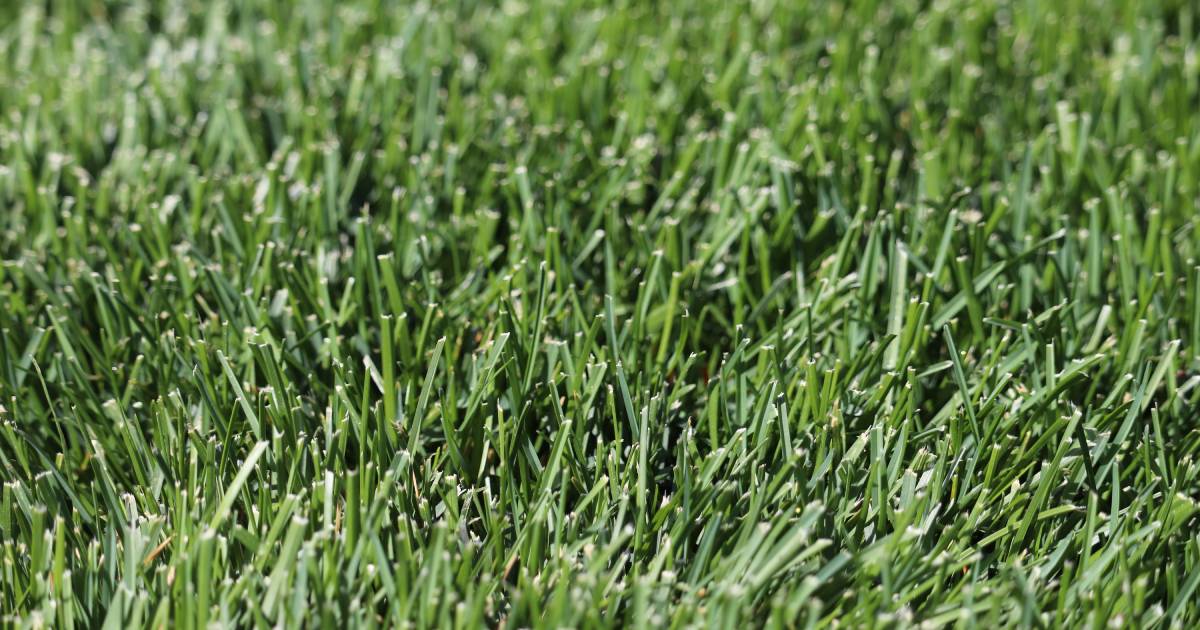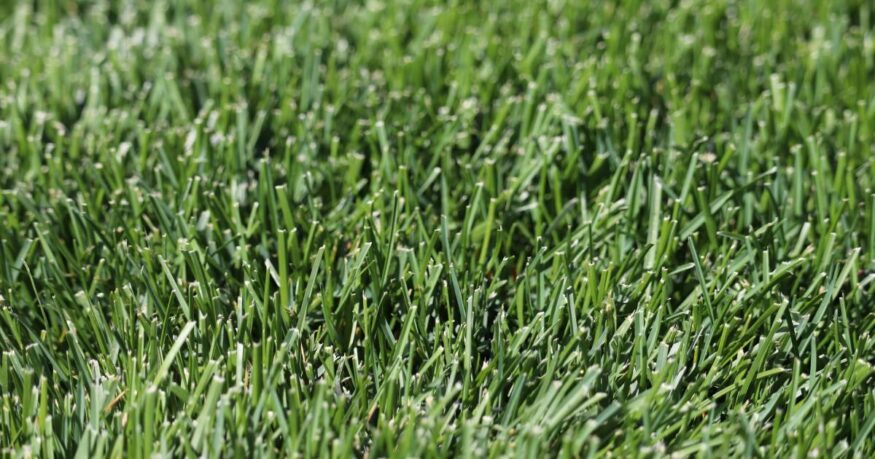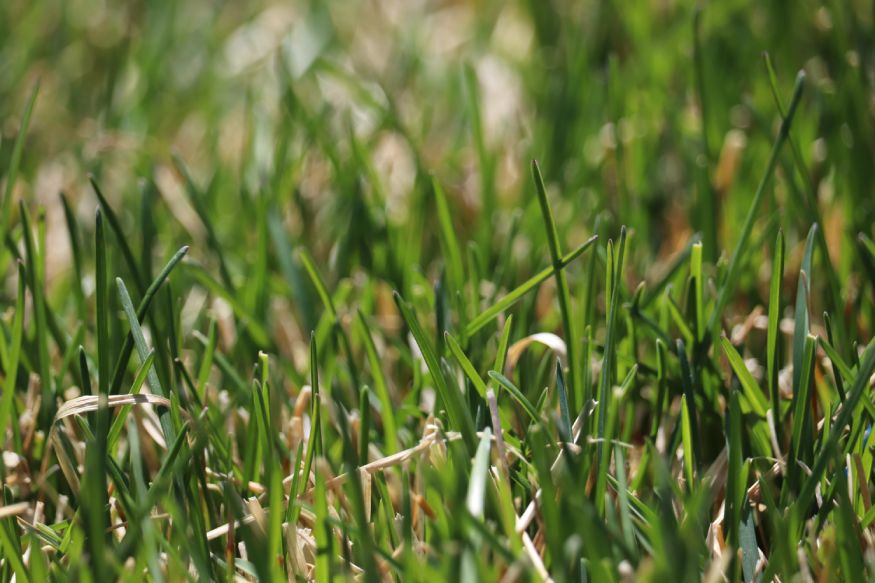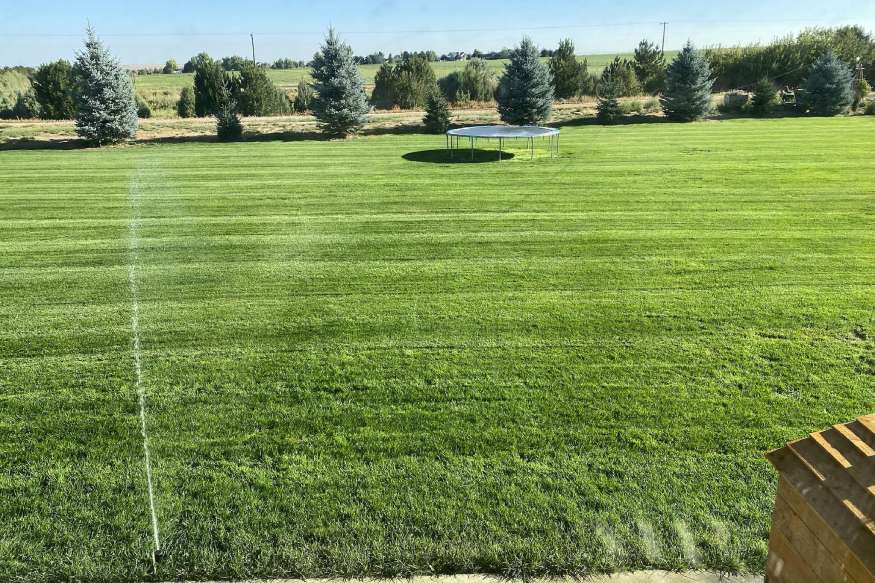Kentucky bluegrass is the perfect turfgrass for homeowners who want a lush, green lawn that’s resilient to foot traffic. But don’t think that durability means Kentucky Bluegrass is maintenance-free. Kentucky bluegrass requires a lot of water, careful fertilization, and a strict mowing schedule to live up to its potential.
In this guide, we’ll look at important Kentucky bluegrass characteristics to determine if KBG is right for your yard. We’ll also walk you through our detailed lawn care calendar so you know what to do each season to keep your Kentucky bluegrass lawn looking great.
Kentucky Bluegrass Overview
| Kentucky Bluegrass, Also Known As | Poa pratensis L. |
| Type of Grass | Cool season perennial |
| Optimal Zones | Northern cool season zone, transition zones |
| Root Structure | Shallow |
| Winter hardiness | Excellent |
| Shade tolerance | Poor to Good |
| Water Requirements | High |
| Drought Tolerance | Poor |
| Self Repair Capacity | Excellent |
| Overall Maintenance Requirements | High |
The History of Bluegrass
Kentucky bluegrass (KBG) is native to Europe and Northern Asia. It is commonly found covering mountain meadows and rolling hills in areas that receive plentiful rainfall. There is also some evidence that Kentucky bluegrass may have been growing in Utah before western settlers arrived. Whether it was brought by pre-Columbian explorers or a holdover from ancient times is not known.
Most of the bluegrass in North America did arrive with the colonists. In fact, Native Americans referred to the grass as “White Man’s Tracks” because it grew everywhere settlers and their livestock went.
In both Europe and America, this lush grass was originally used to fill pastures for horses, cattle, and sheep. In America, it was very popular in Kentucky before spreading throughout most of the Northern states.
Kentucky Bluegrass is a resilient grass that can be overgrazed and still return green and lush the following spring. But its tendency to form thick sod risks excessive water runoff, leading to gully formation and watershed damage.
Today, bluegrass is most commonly used as sod for yards and parks. With proper care in the right environment, it forms thick and lush lawns with a deep greenish-blue color.
Kentucky Bluegrass Characteristics
Kentucky bluegrass has all the right characteristics to be the base for a beautiful yard. But Kentucky Bluegrass is not the easiest to maintain and requires the right climate to thrive.
To help you decide if KBG is right for your home, let’s take a closer look at the characteristics of this grass.
Type of Grass
KBG is a perennial cool-season grass. “Perennial” meaning Kentucky Bluegrass comes back every spring. And “cool season” meaning it does most of its growing when temperatures are below 75 degrees
Like perennial ryegrass and tall fescue, KBG grows the most in the spring and the fall. In mild climates, it can grow throughout the summer and winter as well.
Optimal Zones
KBG is optimal for northern zones, especially those that experience mild summers. Kentucky Bluegrass can also work in transition zones, but will require extra water and care during the hot summer months.
Root Structure
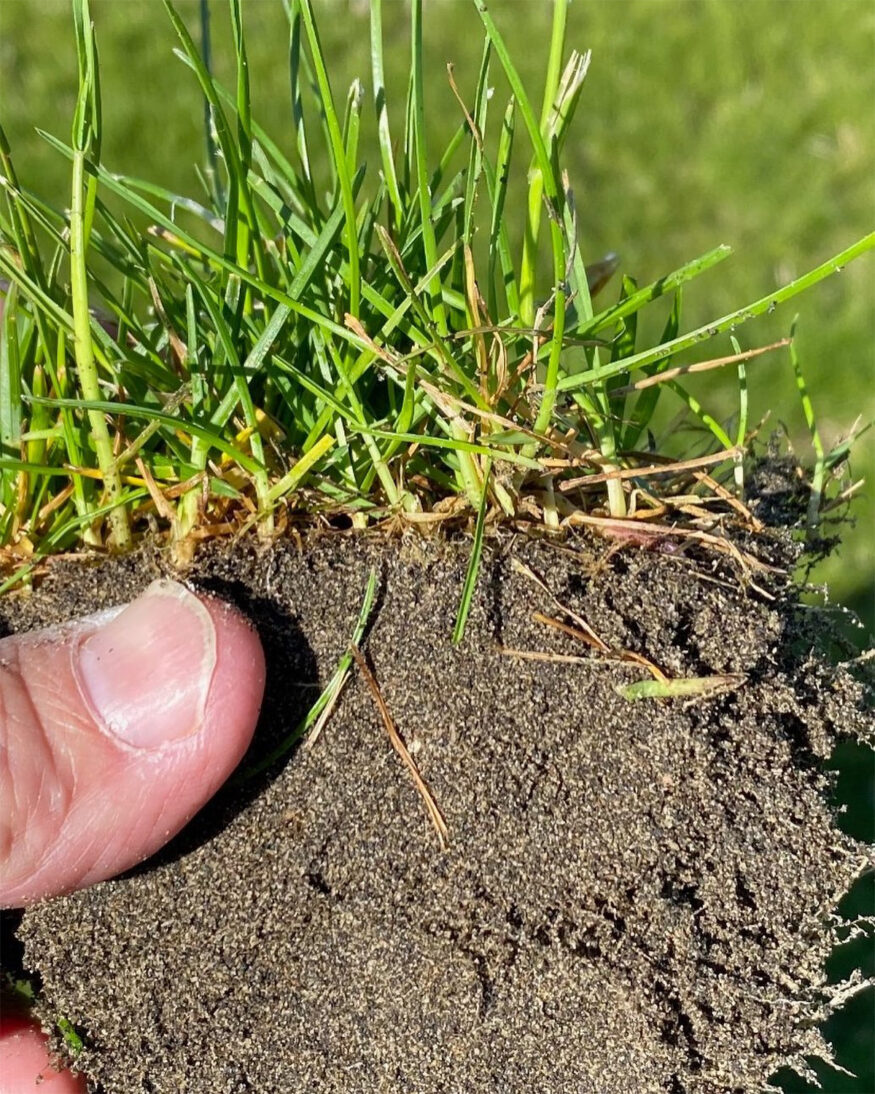 Source: mtnviewseeds on Instagram
PIN IT
Source: mtnviewseeds on Instagram
PIN IT
The root structure of Kentucky bluegrass is shorter than native grasses and many other turf grasses. It evolved in humid, rainy environments where a deep root structure was not necessary.
Mowing your KBG too short and overfertilizing with nitrogen leads to even shallower roots. As does over-watering. However, unlike more drought-tolerant grass species, infrequent, deep watering will not result in adequate root growth to support the grass through dry periods.
Color
A healthy KBG lawn will be anywhere from rich emerald to a blue-green in color.
Following the fertilizer schedule in our maintenance calendar will result in the rich color of Kentucky Bluegrass being maintained.
Winter Hardiness
Of all the cool-season grasses, bluegrass tends to be the most cold-tolerant. In extreme temperatures, it will go dormant but typically greens up by spring.
In less harsh environments, it will retain its green color throughout the winter. In regions with mild winters, growth may continue through the colder months.
Shade Tolerance
KBG is somewhat tolerant of shade but prefers to grow in full sun. The most shade-tolerant varieties need a minimum of 4 hours of sunlight per day.
Note: Lawns with both shady and sunny spots would benefit from a mixed grass option such as fine fescue and Kentucky blue.
Water Requirements & Drought Tolerance
Because of its shallow roots, KBG is not a good option for climates prone to drought. It requires 1 inch of water per week or more in hot temperatures.
While widely considered not drought tolerant, KBG will survive periods without water. But it does so by going dormant and turning brown. For most homeowners, this is not ideal.
Self Repair Capacity
Kentucky bluegrass has an excellent capacity to self-repair. Kentucky Bluegrass produces tough rhizomes below the turf surface capable of producing leaves. These rhizomes are far tougher than the leaves above ground and will quickly replenish bare spots as needed as well as helping to form a dense, thick turf.
Mixing Bluegrass With Ryegrass or Other Grasses
Kentucky bluegrass is often mixed with ryegrass, although usually as a minor part (80% ryegrass, 20% bluegrass).
This is due to the fact that, unlike rygrass, KBG spreads via rhizomes and also has a great ability to repair any damage to itself. The bluegrass helps to hold the ryegrass together and results in a more durable turf.
Kentucky Bluegrass Maintenance & Lawn Care Calendar
KBG requires year-round care to look its best.
For new Kentucky Bluegrass lawns, spread seed at a rate of 2 to 3 pounds per 1,000 square feet in the early fall. Alternatively, you can set seed in the spring as soon as winter temperatures begin to warm.
Once the seedlings have reached 2 inches in height, you can begin following our Kentucky bluegrass lawn maintenance plan, below.
Spring Care
Kentucky bluegrass grows the most in the spring. As such, it requires the most maintenance this time of year.
Mowing
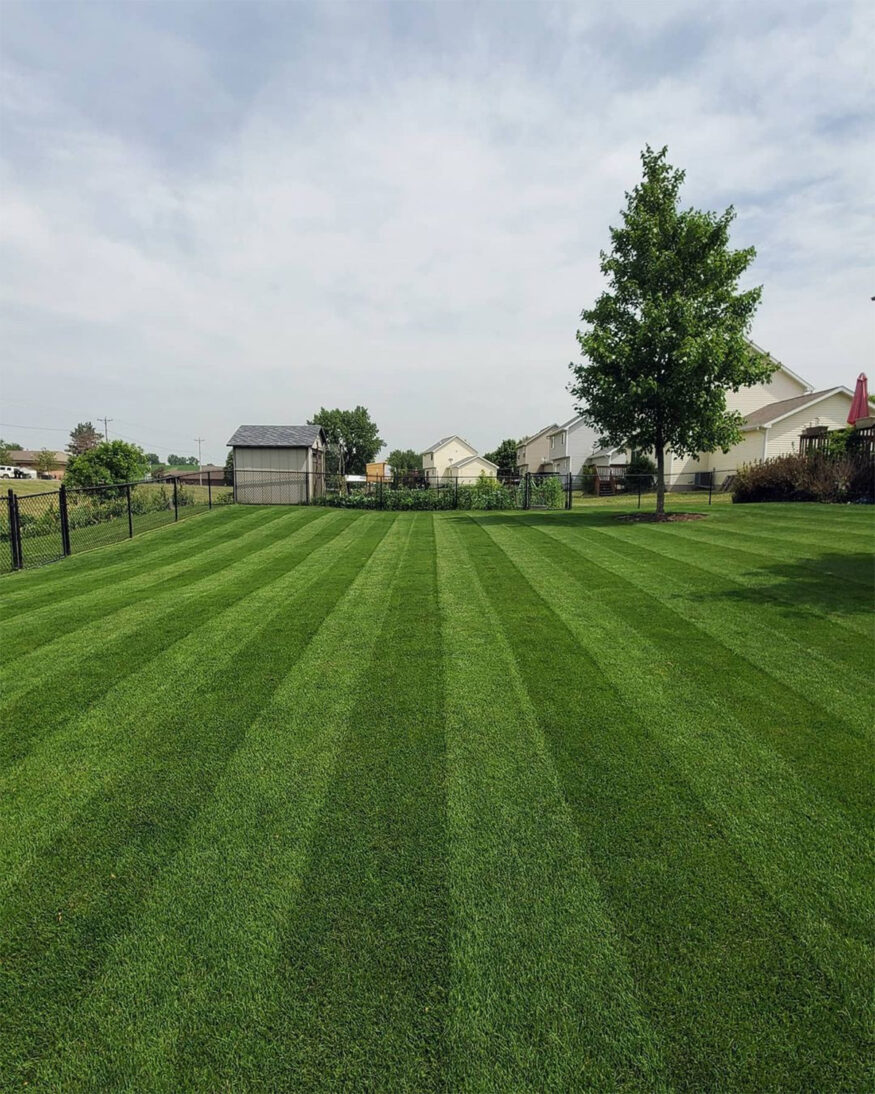 Source: ryanknorrlawncare on Instagram
PIN IT
Source: ryanknorrlawncare on Instagram
PIN IT
Cut grass for the first time when it reaches 3 ½ inches in height. Cut to a minimum of 2 ½ inches. If winter left packed snow on the ground and you see signs of snow mold, be sure to bag the first round of clippings.
Subsequent mowing should be done frequently to avoid taking more than ⅓ the height of the grass off to get to 2 ½ inches in height. In wet conditions, you may have to mow every 5 to 7 days. Leave grass clippings on the lawn to provide natural fertilizer.
Note: Mowing bluegrass too short in the spring results in slower root growth.
Fertilization
Fertilize early in the growing season (as temperatures first begin to warm) with a high nitrogen, low phosphorus fertilizer. This will promote leaf growth for a lush, thick lawn. Fertilize every 4 to 6 weeks through the spring.
Note: For hotter, drier climates, use a lower nitrogen fertilizer for your second and third fertilization. High-nitrogen fertilizer decreases root growth and makes KBG more susceptible to drought during the summer.
Weed Control
Apply a pre-emergent weed control option early in the spring. Use spot control weed killers on young weeds as soon as they sprout or pull them out manually.
Watering
Bluegrass requires 1 inch of water per week. Irrigation is not typically necessary during the first months of spring in most climates. As natural rainfall decreases, begin watering every other day to supply 1 inch of water over the course of each week.
Watering in the early morning is generally the best time. This period reduces water loss while restricting how long foliage stays wet to avoid fungus problems.
Pest Control
White grubs can be problematic in KBG lawns during the spring. Treatment products can be applied from May through early August. Before and after this time, the grubs are too big to succumb.
Aeration
Aerating should be done now if it was not completed in the fall. Do it once spring growth is at its peak. This will allow your grass time to recover before the hot summer temperatures.
Summer Care
Because Kentucky bluegrass is one of the cool-season grasses, it does not grow much in the summer. If temperatures get too hot, it may even go dormant and turn brown. Summer maintenance is largely centered around keeping your lawn watered.
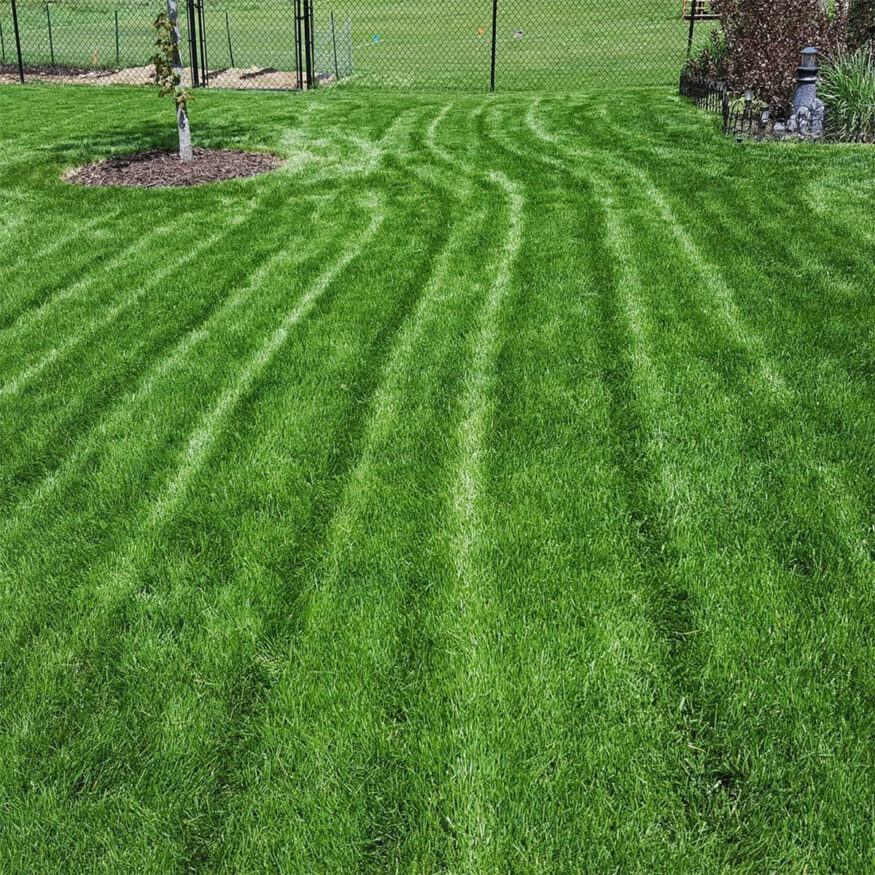 Source: ryanknorrlawncare on Instagram
PIN IT
Source: ryanknorrlawncare on Instagram
PIN IT
Mowing
To help protect against sunscald and encourage root growth, raise your mower height to 3 ½ inches minimum in the summer. Mow often enough so that grass doesn’t get above 5 inches between trimmings.
Depending on how much you water, you’ll likely have to mow every 5 to 14 days.
Fertilization
As leaf growth slows in the summer, rhizome growth increases. If you have a heavy-use lawn, this will add to its durability. But it will also create more thatch that can negatively impact water and nutrient absorption.
We recommend using a medium-nitrogen fertilizer on young lawns to allow for ample rhizome development. For older lawns, a high-nitrogen fertilizer will reduce rhizome growth and increase leaf production and turf thickness.
Note: Fertilize once in the middle of summer in the evening and follow with a thorough watering to prevent burning. If your lawn has gone dormant, save this fertilization round for the end of summer.
Watering
Root growth in bluegrass slows when soil temperatures rise above 70 degrees and stops completely above 80 degrees. This means you won’t be able to train deeper roots this time of year. Instead, focus on providing 1 inch of water per week through daily or every-other-day waterings.
If you live in a dry climate, it may be more cost-effective to let your bluegrass go dormant. In this case, provide 1 inch of water every 2 to 3 weeks through multiple watering sessions.
Pest Control
Continue white grub control, if needed, using a targeted pesticide until August. Additional bug treatments should only be used if you have an active infestation.
Overseeding
If your grass suffered in the summer heat, you may want to overseed your lawn during the last month of summer. This will help fill any dead spots that do not come back and produce greener lawn sooner.
This is generally only needed for newer lawns or those that did not receive any water over the summer. Established bluegrass that was watered occasionally should have no problem coming back from heat dormancy.
Fall/Autumn Care
The autumn season is all about preparing your lawn for winter. Kentucky bluegrass that enters winter with enough nutrients and with its other needs met will come back stronger in the spring.
Mowing
Lower your mower to a height of 2 ½ to 3 inches. As always, be sure to mow often enough to take only a maximum of ⅓ the blade length off each time. KBG will start growing again as temperatures decrease, so mowing will need to be done every 5 to 7 days.
As the season progresses, set the mower a little higher to 3 ½ inches. This will help induce carbohydrate accumulation in the rhizomes, which your grass will need to survive the winter and come back strong in the spring.
For the final mow of the season (around the time of the first frost) set your blade height between 2 ½ and 3 ½ inches.
Fertilization
Fall is the best time to have your soil tested to find out what nutrients are lacking. Choose the right fertilizer to supply these nutrients and apply it in September and again in early November. You want the last fertilization to come after the grass has stopped growing but while it is still green.
Note: Avoid high-nitrogen fertilizers this time of year. Too much nitrogen will stop plants from accumulating carbohydrates. Without enough stored carbohydrates, your KBG will struggle to survive the winter and will not come back as lush in the spring.
A 3-1-2 nitrogen-phosphorus-potassium ratio is generally what you want this time of year. Even better, however, is a specially formulated winterizer fertilizer.
Watering
Continue watering as needed to give your Kentucky bluegrass 1 inch of water per week through the first months of fall. As temperatures drop, gradually decrease watering to ½ an inch per week.
Keep an eye on precipitation accumulation after your irrigation system has been winterized. If it’s a dry fall, you may have to hand water.
Pest Control
As you did in summer, treat pests only on an as-needed basis. Blanket pest control options are not as effective as targeted measures.
Aeration and Dethatching
Fall is the best time to have your lawn aerated to avoid compact soil. Aerated soil is better able to accept nutrients and water, making for a greener start to the new year.
Established Kentucky bluegrass lawns (older than 2 years) will need to be dethatched every fall. By removing the mats of dead grass and rhizomes, you increase drought tolerance and decrease disease risk. Your grass will also look greener through the winter.
Overseeding
Fall is also the best time to overseed your lawn, if needed. For newer lawns, overseed with KBG to add density. This will help protect against spotty growth in the spring and help crowd out weeds.
If your lawn struggled this year, you may consider overseeding with tall fescue. This hearty cool season grass tolerates drought and heat better than KBG. By mixing the seeds with your bluegrass lawn, you can take advantage of both grasses’ strengths.
Note: Overseeding can be done as soon as fall arrives. And it must be done no later than 45 days before the first frost in order to give new sprouts time to establish.
Winter Care
In cold climates, winter KBG maintenance will be minimal. However, if you live in a warmer climate, your grass will keep growing throughout the winter. In this case, follow our guidelines for winter maintenance for best results.
Watering
Watering is typically not needed in the winter. But, if you are experiencing a particularly dry winter, you may have to hand water on occasion. Shoot for about ½ inch of moisture each week. Alternatively, you can let your lawn go fully dormant by reducing watering to 1 inch every 3 weeks.
Overseeding
If you missed the window for overseeding in the fall, you can try again in late winter. The thawing and freezing cycle that occurs around February helps work seeds into the soil. Once the ground unthaws for good, the seed will begin growing and be well-established by summer.
